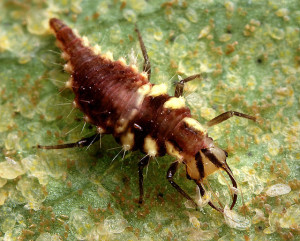According to a recent online discussion among Texas entomologists, add the tiny lacewing larva to the long list of outdoor critters that can bite and irritate people. Joe Lapp, spider enthusiast from Austin, TX, recently reported seeing a lacewing larva at the site of a prick-like sensation on his arm while outdoors. The bite itched over the next two days and left a little red mark, similar to a mosquito bite. This prompted others to report similar experiences.
We normally think of lacewings as beneficial insects–which they are. Lacewings are voracious predators on a variety of soft-bodied insects, including aphids and some caterpillars. The adult lacewing is an attractive, delicate green or brown insect named for the lace-like pattern of veins in its wings. Savvy gardeners praise lacewings for their aphid-hunting prowess and smile when they see their distinctive eggs on vegetable plants.
It turns out that the mouth parts of lacewings, and other predatory “neuropterans” (members of the insect Order Neuroptera), are unique in the insect world. Lacewing mouth parts don’t follow the classic chewing- or piercing/sucking-model seen in most insects. Instead, neuropterans have developed an innovative approach to teeth. Lacewing mandibles are gracefully long, slender and curved, with hollow grooves on one side. These grooves are covered by maxillae (another universal insect mouth part) to form long, sucking tubes. Think of those old-fashioned ice tongs, used by icemen to grasp and pick up blocks of ice. Now imagine the tines of the ice tongs are hollow. The lacewing uses its mouth parts to pierce and suck body juices out of their prey, not unlike a good set up for a horror flick. Imagine Freddy Kruegger with ice tongs!
According to Dr. John Oswald, Professor of Entomology at Texas A&M University and expert on Neuroptera, there are several records in the scientific literature documenting accounts of lacewing bites on humans. “This is an occasional behavior,” says Oswald. “It’s hard to say why one individual bites, but others don’t. Provocation (not always intentional or known) is probably part of the story, higher aggression by some individuals is another possibility…”
Whatever the intent, there’s more to the story. Before sucking, the lacewing’s hollow food channel is often used to inject a special saliva. This saliva contains enzymes to help it “pre-digest” its intended prey. Because the lacewing can only imbibe on liquids, the body parts of its prey must first be dissolved. When a lacewing larva bites a human, it’s likely that any persistent itch or redness is due to the saliva injected at the site of the bite, Oswald said.
So the next time you’re outdoors and see a lacewing, be glad for your size. It you were the size of an aphid, “Freddy Lacewing” would likely be the last thing you would ever want to see. Happy Halloween!
